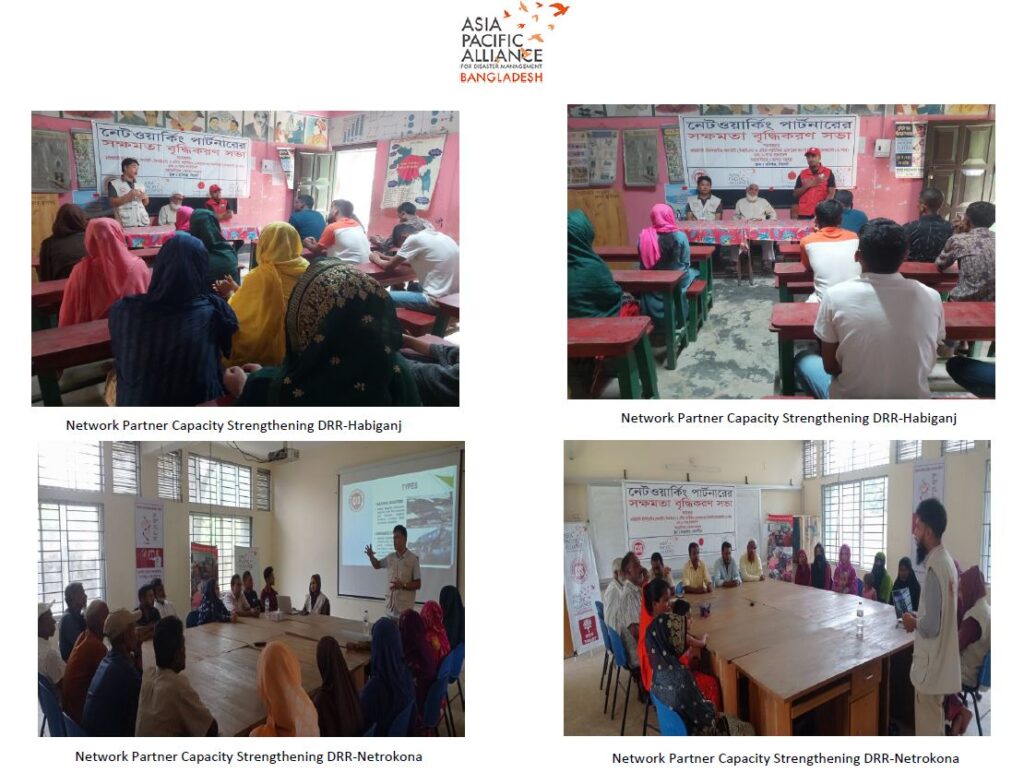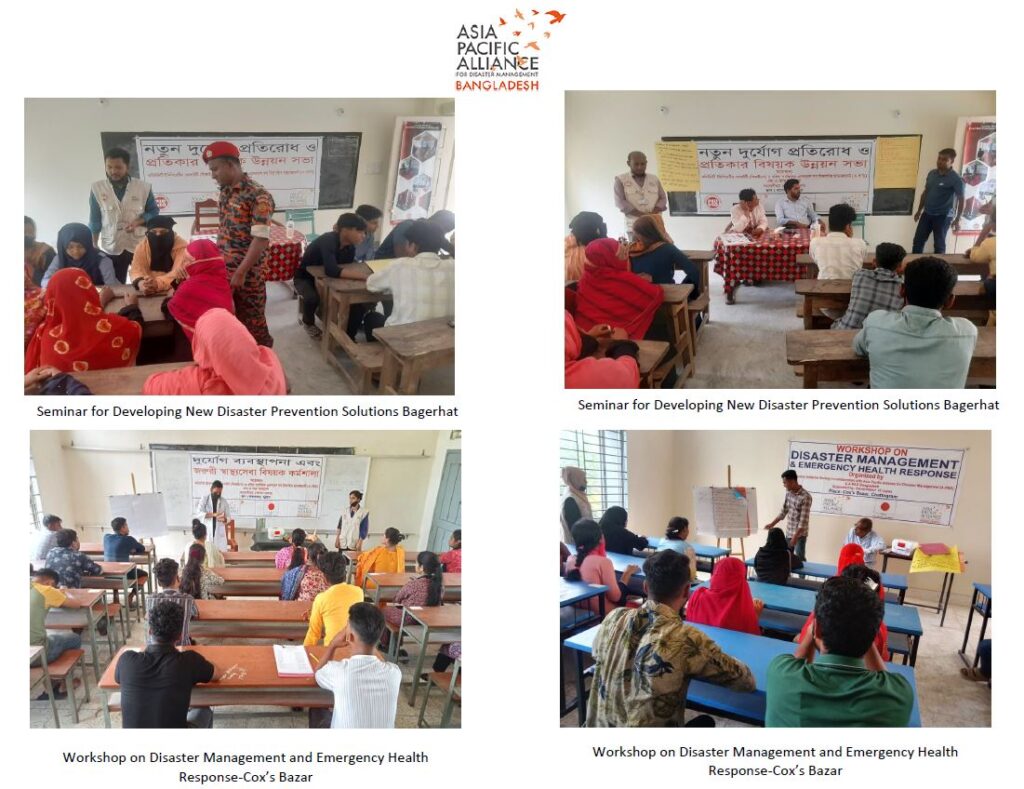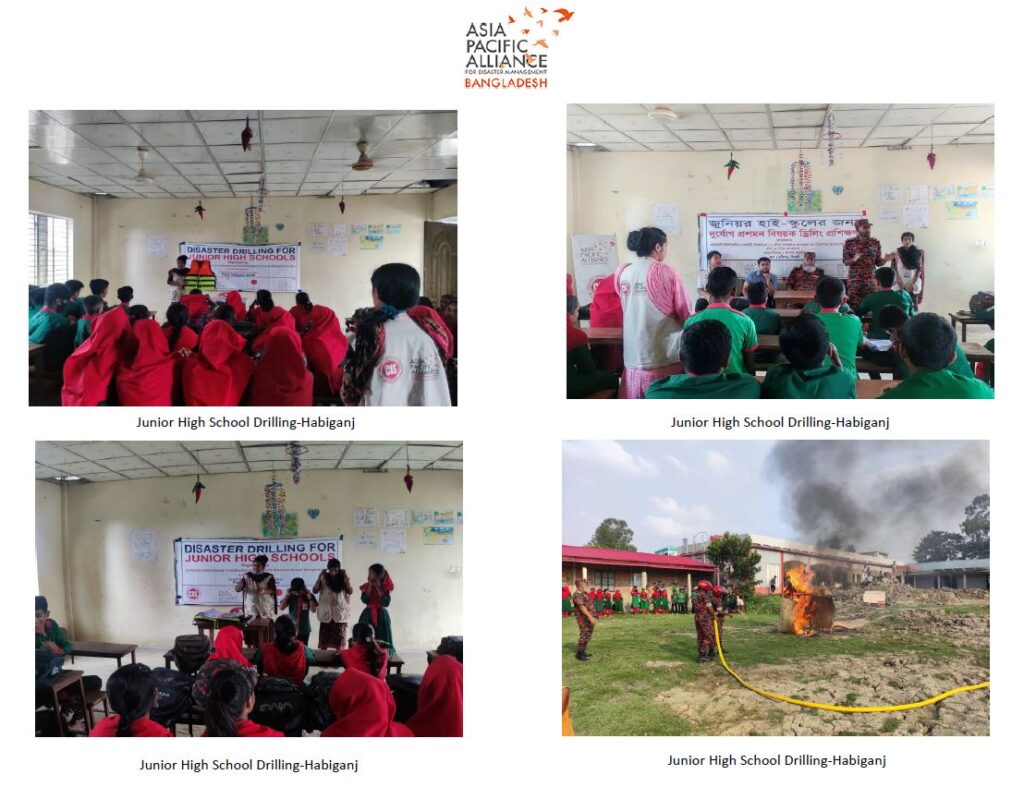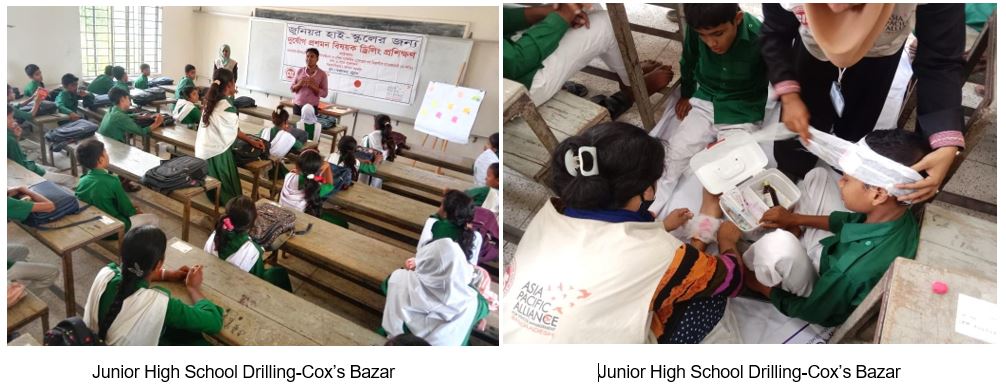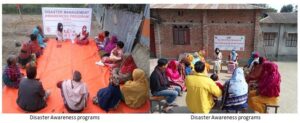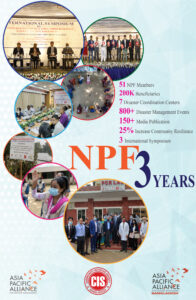Project Title: Strengthening Capacity for Sustainable Disaster Management Network by involving multi-sectoral platform Project Period: 17 January, 2024– 16 January, 2025 (12 month)
- Project Activities and Accomplishments
Bangladesh is ranking as one of the most disaster-prone countries. People in Bangladesh are often affected by water-related natural disasters, including floods, riverbank erosion and cyclones. In addition, recent rapid urbanization increases the risks for earthquake as well as man-made disasters. National Plan for Disaster Management (NPDM) 2021-2025 exemplified the strategic plan of the Government of Bangladesh in its Vision and the Mission of the Ministry of Disaster Management and Relief (MoDMR) between 2021 and 2025 towards building resilient nation. Bangladesh GOVT. has NPDM 2021-2025 has core goals for actions to save life, reduce economic losses in every disaster cycle stages which includes Disaster Risk Reduction (DRR), Humanitarian Response and Emergency Recovery Management. In Bangladesh most hazards impact: flood; cyclone and surge; tornado; earthquake; riverbank erosion; landslide; salinity intrusion; drought; tsunami; lightning; arsenic contamination; human-induced hazards and health hazards. The last hazard has potential for assuming significance because of the emerging risks in Bangladesh.
A-PAD Bangladesh started project from January 2023 and presently continue it 17 January 2024 to build up capacity on disaster management. It communicates with the different sectors like local community, community leaders, stakeholders, GOVT. officials continuing training on disaster management. To hold training program A-PAD Bangladesh staff organized small community meeting to sharing ideas on disaster and introduced them about A-PAD Bangladesh activity. A-PAD Bangladesh working 8 divisional areas.
There are 1 health workers in each divisions whose are doing home visit and aware the local community about basic disaster awareness. The health workers gave basic ideas about disaster management. A-PAD Bangladesh working at the rural areas. If there would be any directions or announcement from GOVT. or any disaster related news has been published the health workers delivered the message to the local community. Total 3,921 persons were benefited from A-PAD Bangladesh on April 2024.
A-PAD Bangladesh attended coordination meeting at the 8 divisions in Office of Deputy Commissioner. At that meeting different NGOs had joined and explained their activities. Besides this what will be the next activities of the GOVT. and NGOs were discussed at that meeting.
1. Strengthening of disaster risk reduction and disaster response system functions through the Emergency Disaster Management Coordination Center | ||
Activities | ( Outcome 1 ) The Emergency Disaster Management Coordination Center operated under this project will function as a disaster response base in each region, leading to the disaster risk reduction in the community and the strengthening of its disaster response system.: | Project Status: Achievements vs Outcome: If the activity is behind the schedule, please write the reason. |
1-1 Operation of Emergency Disaster Management Coordination Centers Target:Local communities 10 people×25 days×8 divisions×12 months =24,000 people | 【Indicators of Outcome】 1-1 The Emergency Disaster Management Coordination Center will be used for coordination meetings among partner organizations and relevant stakeholders during normal times, and will also serve as a center for health and public health guidance for the local residents. In the time of emergency, health services will be provided by emergency health workers. The Emergency Disaster Management Coordination Center will be used by 24,000 local residents (annual average) in the target area. (Indicator:number or visitors, record of services provided) 1-2 Through the Disaster Management Awareness Program, community residents will receive the latest disaster information and knowledge on how to respond to disasters, and people’s awareness of disaster prevention and response will be increased. (Indicator:Community disaster preparedness report) | Total 2,798 people visited to the Disaster Management Coordination Center to discuss about disaster preparedness and health related issues. Dhaka: 340 Persons Cox’s Bazar: 347 Persons Pabna: 330 Persons Bagerhat: 375 Persons Patuakhali: 360 Persons Habiganj: 350 Persons Rangpur: 360 Persons Netrokona: 336 Persons Total = 2,798 Persons |
1-2 Disaster Management Awareness Program Target:Local communities, Community leaders, Local NGOs, Private company workers, government officials 15 people × 8 divisions × 4 times ×12 months =5,760 people | A-PAD Bangladesh conducted Disaster Management Awareness programs at the 8 divisional areas where 508 persons have participated. Total 4 times training organized at each divisional areas. Dhaka:15 Participantsx 4 Sessons= 60+2=62 Participants Cox’s Bazar: 15 Participantsx 4 Sessons= 60+5=65 Participants Pabna: 15 Participantsx 4 Sessons= 60+3=63 Participants Bagerhat: 15 Participantsx 4 Sessons= 60+4=64 Participants Patuakhali: 15 Participantsx 4 Sessons= 60+2=62 | |
|
| Participants Habiganj: 15 Participantsx 4 Sessons= 60+3=63 Participants Rangpur: 15 Participantsx 4 Sessons= 60+6=66 Participants Netrokona: 15 Participants x 4 Sessons= 60+3=63 Participants |
2. Expansion of disaster management network to improve community vulnerability | ||
| (Outcome 2)The network of NPF will be expanded and the capacity of each region for disaster prevention and response will be strengthened. |
|
2-1 Network Partner Meeting Target : Local communities, Community leaders, Local NGO, Private Company Workers, Government officials 50 people × 5 villages × 8 divisions = 2,000 people | 【Indicator of Outcome】 2-1 Strategies, mechanisms, and action plans for disaster reduction cooperation are developed in each region through discussions at network partner meetings, and a framework for disaster reduction cooperation is established. (Indicator:Strategic Plan) 2-2 MOUs signed with at least 5 new organizations, including private companies, in A-PAD Bangladesh NPF to expand the network (Indicator:number of new MOUs signed) 2-4 Resources possessed by A-PAD BGD partner organizations are provided in emergency disaster response, and play the role of that organization in times of emergency. | A-PAD Bangladesh organized 5 days Network partner Meeting at 5 villages in Pabna. Total 262 participants has joined the meeting. 06 April 2024- Nazirpur: Total Participant- 50+2=52 Participants 15 April 2024-Dapunia: Total Participant- 50+1=51 Participants 18 April 2024- Krishnadiar: Total Participant- 50+2= 52 Participants 20 April 2024- Tikori: Total Participant- 50+3= 53 Participants 22 April 2024- Hariyabariya: Total Participant- 50+4=54 Participants The meeting was conducted by CIS and A-PAD Bangladesh, coming up with different sector plans for disaster management that would help in the future. During the meeting, different issues were discussed, such as thunderstorms, drought, floods, pandemics, and fire. Thunderstorms were the primary concern in the Nazirpur village, while drought was the major issue in the northern |
| (Indicator:List of resources such as supplies, human resources and donations provided by partner organizations for emergency disaster response) | part of Bangladesh and was discussed in Dapunia. The meeting held in Krishnadiar focused on floods, and it was emphasized that early warning systems could help minimize the risk. The networking partners meeting held in Tikori and Hariyabariya addressed the pandemic situation and there was discussion on future strategies how people will react if there any pandemic happens and how to cope with it. Finally, the meeting that took place on 22nd April 2024 discussed the issue of Heat waves and how to survive in this situation. |
2-2 Disaster Preparedness Campaigns Target:Partner organizations and local communities 50 people × 2 times × 8 divisions = 800 people |
|
|
2-3 Network Partners Capacity Strengthening (DRR) Target : Partner organizations 20 people × 2 organizations × 2 times × 8 divisions = 640 people |
| A-PAD Bangladesh Organized Network Partner Capacity Strengthening DRR at 2 divisional areas in Mymensingh and Habiganj. 03-04 April 2024, Mymensingh, Total Participants 40+1= 41 Participants 06-07 April 2024, Habiganj, Total Participants 40+3= 43 Participants The situation is worsened by the depletion of forests and |
| the emission of carbon dioxide by industries, leading to a | |
| rise in temperature and increased occurrences of | |
| heatstroke. To address these issues, CIS organized a two- | |
| day training program in Barhatta, Netrakona, in April 2024. |
|
| The focus of the program was to build the capacity for emergency response regarding heat stroke and other recent disasters. The first day of the meeting saw Md. Saifur Rahman Khan, UP Member of Barhatta, emphasizing the heat stroke situation in Netrokona and its impact on the world due to rising temperatures. The second day featured discussions on upcoming floods during the rainy season, which could submerge roads, and the importance of keeping dry food in case of emergency situations. CIS is playing a vital role in creating awareness programs, conducting training, seminars, and workshops on disaster reduction and providing emergency support during incidents like floods and fires. The organization has taken significant steps during disasters and assisted the vulnerable people, including cases of fire in the villages of Barhatta. The locals have witnessed the immediate medical support, food, and drinking supplies provided by CIS, which continues its emergency services in the villages of Barhatta with increasing frequency of disasters. The training program was attended by many, including Mr. Nipom Chakma, Project Officer, Jorna Akhter, UP member from the host organization, and RipaAkter, Volunteer Team Leader, among others. The meeting concluded with a colorful closing ceremony that was attended by CIS participants. The Network Partners Capacity Strengthening (DRR) Workshops are a series of events that aim to enhance the |
|
| capacity of organizations to respond to disasters and reduce their impact. The workshops adopt a systematic approach to Disaster Risk Reduction (DRR), which involves reducing the impact of disasters on communities by understanding their risks, vulnerabilities, and implementing measures to mitigate those risks. One of the workshops, organized by CIS in Habiganj, was held on April 6-7, 2024, and it played a significant role in enhancing collaboration and preparedness for Disaster Risk Reduction (DRR) in the Habiganj region. The event brought together participants from various partner organizations, including government agencies, NGOs, and community-based organizations. The workshop included a range of activities aimed at equipping the participants with the knowledge and skills to effectively manage and mitigate disaster risks. The activities included training sessions, knowledge sharing, and collaborative exercises. During the training sessions, participants engaged in discussions on best practices in disaster management, and learned about the latest technologies and methodologies for risk assessment and mitigation. They also learned how to develop action plans for future emergencies. The workshop underscored the importance of community-driven approaches to disaster resilience, emphasizing the significance of cooperation and coordination among stakeholders. Throughout the workshop, participants engaged in a series of activities |
|
| geared towards building expertise, sharing knowledge, and fostering partnerships. |
2-4 Seminar for Developing New Disaster Prevention Solutions Target : NGO, Disaster prevention related government organizations, Private sector personnels 30 people ( 2days ) × 8 divisions × 2 times = 480 people |
2 days seminar has been organized in Bagerhat. Total 35 participants from 3 divisional areas had joined the seminar.
17-18 April 2024, Bagerhat, Total participants 30+5=35 Participants
The Bagerhat Public Health Engineering Department estimates that the Sharankhola Upazila has a total population of 1.24 lakh, and on average, a person needs 80 liters of water per day. However, only 40 to 45 percent of the people in the upazila have access to safe water due to various public and private initiatives. The rest of the population depends on water from various sources. To address the water crisis, there have been discussions on how people can use rainwater and preserve it for future use. This will enable the residents of the area to have access to safe drinking water and reduce their dependence on other sources of water. This situation highlights the need for conservation authorities to work together to address common climate change issues within the shared regional natural and social ecosystems. It is essential to identify common issues within the mutually shared world heritage framework to protect these sites from further damage. |
|
| CIS conducted a two-day seminar in Bagerhat on developing new disaster prevention solutions. The primary focus of the seminar was on addressing the drinking water crisis in the region. The seminar aimed to identify ways to tackle the issue of salinity and make safe drinking water more accessible to the residents of the area. The impact of climate change has also led to a tidal surge caused by Amphan, which has resulted in the loss of fresh water sources for those living on the banks of the Baleshwar river. |
2-5 International Symposium on DRR Target : Government, Local government, private company, NOG, partner organization, representative of A-PAD member countries, etc. 200 people |
| |
3. Practical training to improve resilience of local communities | ||
| ( Outcome 3 ) Contribute to improving the disaster resilience of local communities through practical training. |
|
3-1 Disaster response capacity building of local community level in Health and hygiene field | 【Indicator of Outcome】 3-1 a) Establish networks of community leaders who can lead disaster response and emergency health response in all districts of |
|
3-1 a) Workshop on Disaster Management and Emergency Health Response Target : Local residents, Community leaders, Local NGO workers 25 people ( 2 days ) × 8 divisions × 2 times = 400 people | Bangladesh. (Indicator:Number and the List of community leaders for disaster response/emergency health in each 8 districts.)
b) Networks of human resources with the skills and know-how to respond to health emergencies will be established in all districts of Bangladesh to provide health services to the local residents in times of emergency. (Indicator:Data of NGO health personals who can respond in emergency. Number of residents who received the services in the cases of activities during emergency disaster in each 8 districts.) 3-2 a) Disaster preparedness training and drills will be documented in a manual, and women, youth groups, and local stakeholders who participate in the drills will be granted certificates of completion and work as disaster volunteer teams during actual disasters. (Indicator:Drilling Manual, Cases of activities in emergency disaster response) | A-PAD Bangladesh conducted 2 days workshop at Rangpur and Cox’s Bazar total 55 participants joined the training workshop. 16-17 April 2024, Rangpur, Total 25+3=28 participants 27-28 April 2024, Cox’s Bazar, Total 25+2=27 Participants
The training program emphasized a community-based approach to disaster management, recognizing that communities possess innate skills, capacities, and knowledge that are vital in enhancing the risk-reduction process. Communities are the local experts who know their own risks and needs and can lead response efforts, making a significant difference in their communities. Throughout the training, participants were exposed to various topics, with the module being the most critical element as it has the ability to make the most significant impact. The training program aimed to prepare individuals not only to help themselves but also their families and neighbors by receiving training on disaster preparedness and response. It is crucial for organizations to recognize the need for employee training and skills development in enhancing their performance, particularly in emergency communication and building effective disaster preparedness and response. In conclusion, the CIS training program was a significant step in building capacity for emergency health response in Rangpur, Bangladesh. |
| b) Disaster drills at junior high schools will be documented in a manual so that students who participate in the drills will have the skills to take appropriate action in the event of a disaster. (Indicator:Drilling Manual, Report of emergency disaster response) | CIS in Cox’s Bazar conducted a comprehensive two-day workshop on disaster management and emergency health in Cox’s Bazar Sadar. The training aimed to increase awareness and understanding of disaster risk reduction and emergency health. The program covered various essential topics such as First Aid, CPR, rescue, and recent disasters such as Heatwave, storm, Dengue, Conjunctivitis, and more. It also focused on developing emergency health response capabilities for local government health workers, NGOs, private organizations, and other stakeholders to address common health issues during and after climate disasters. The participants discussed disaster preparedness and the responsibilities of health providers during a disaster. The trainers, Dr. Shomir Pal and Dr. Abdus Salam, emphasized the importance of First Aid, fracture management, rescue management, pregnant women’s health care, child health care, and preparing cross-sectoral guidelines for disaster response cooperation in consultation with local communities, teachers, leaders, and NGOs. |
3-1 b) Training of Local Health Workers on Disaster Health Activities Target : Health workers who belong to local NGOs | A-PAD Bangladesh organized local health workers training at Pabna. Total 22 participants joined the training. 23-25 April 2024, Cox’s Bazar, Total 20+2=22 Participants
The training program organized by CIS for local health workers in Pabna from 23-25 April 2024 was a comprehensive and detailed program aimed at enhancing |
or civil organizations 20 people ( 3 days ) × 8 |
| the knowledge and skills of local health workers in managing health-related issues during disasters. The |
divisions = 160 people | training program was meticulously designed to cover a wide range of topics such as disaster risk reduction, | |
| emergency response, and public health interventions | |
| during disasters. The program was divided into various | |
| modules, each covering a specific aspect of disaster health | |
| activities. During the course of the training program, | |
| participants were trained to conduct rapid health | |
| assessments, identify and manage common health | |
| problems during disasters, and provide psychosocial | |
| support. The theoretical sessions focused on building a | |
| strong foundation of knowledge, while the practical | |
| sessions provided hands-on experience in applying the | |
| knowledge and skills learned in simulated disaster | |
| scenarios. | |
3-2 Strengthening disaster |
| |
response capacities of | ||
local communities | ||
through disaster | ||
drilling training | ||
3-2 a) | Two days drilling program organized in Galachipa where 22 | |
Women Empowerment and | women has been joined the drilling program. | |
Capacity Building |
| |
Target : Women’s groups | 23-24 April 2024, Galachipa, Total 20+2=22 Participants | |
in target villages 20 people ( 2 days ) × 8 divisions × 2 times = 320 people | The second day was a practical session where the participants were given hands-on training on the preventive measures and response techniques. The training |
|
| was especially important as Bangladesh is prone to severe flooding, and drowning is the leading cause of death in children there, claiming the lives of nearly 50 children per day. Factors like insufficient parental supervision, maternal illiteracy, lack of swimming ability, male gender, children under 5 years, geographical and environmental conditions, seasonality, and disasters contribute significantly to child drowning deaths in Bangladesh. It’s commendable that CIS conducted a drilling session to equip the mothers and women with the skills to save their children from drowning. The training also provided basic instructions to follow during floods and earthquakes. Women are the backbone of the society, and their knowledge and capabilities are critical to achieving a developed and resilient community. Depriving them of education and social interaction only exacerbates their poverty and vulnerability to future disasters. The Women Capacity drill held at Galachipa was a significant step towards empowering the women of the community. The presence of the Senior Station Officer of Bangladesh Fire Service & Civil Defense and his team as trainers was a great addition. The demonstration on how to extinguish cylinder gas and oil fires by cooking was an excellent approach, as such demonstrations by firefighters can be a lifesaver in case of a disaster. |
3-2 b) Disaster Drilling for the Youth and Local Stakeholders Target:Youth in the local private and civic sector 45 people ( 2 days ) × 8 divisions × 2 times = 720 people |
| Youth and local stakeholder drilling program organized in Habiganj and Cox’s Bazar where 48 participants joined. 29-30 April 2024, Bagerhat, Total 45+3=48 Participants
The CIS team was well-prepared and focused on building up the capacity of the participants for emergency response. The program covered a wide range of topics such as the impact of climate change on multiple disasters, ways to protect against lightning, first aid treatment, and basic hygiene and sanitization. The participants were also trained on how to recognize the signs of an impending disaster and how to take appropriate measures to minimize the damage. During the training program, Md Aftabi-E-Alom, a highly experienced fire fighter, shared his insights on fire safety and disaster risk management. He explained the different ways fires could start, such as through short circuits, gas cylinders, or paper, and emphasized the need to adopt different methods to deal with each type of fire. For example, if a gas cylinder is leaking, it’s best to open the door and window of the room and wrap it with wet sacks or blankets if it catches fire. If a fire starts due to a short circuit, the main switch should be closed if possible. In addition to fire safety, the program also covered other types of disasters that are common in the area, such as cyclones, tidal floods, erratic rainfall, cold waves, arsenic contamination, and tornadoes. The participants were trained on how to prepare for these disasters and how to respond quickly and efficiently during and after the disaster. |
3-2 c) Disaster Drilling for Junior High Schools Target:School Children 40 people ( 2 days ) × 8 divisions × 2 times = 640 people |
| Disaster Drilling for Junior High School conducted in 2 Divisional areas Cox’s Bazar and Habiganj. Total 87 participants joined the drilling program. 28-39 April 2024, Habiganj, Total 40+5=45 Participants 29-30 April 2024, Cox’s Bazar, Total 40+2=42 Participants
The main focus on training workshop was on build up on capacity on emergency response during and after disaster. The program started with registration by the school students. It addressed the gathering and spoke on the importance of disaster drilling. It was highlighted that the skills learnt in the program will help the students to use them in their daily lives to save the lives of others in emergencies. First-day sessions included Fire, Earthquake, Rescue management, lifting activity, and live experience of handling disaster victims. On the second day, the sessions were held on bandages, fracture management and Demonstration Practical. In the end, students were divided into groups, one group acted as victims, and one group as rescue team. Student feedback was collected and students expressed their gratitude towards the resource person and organizers for arranging live sessions and making the event fruitful. The drill was carried out systematically, with the ringing of the fire alarm and announcement by the respective Vice Principal, Headmistress and Supervisor. The students were evacuated to their designated open |
|
| assembly point as per the colour-coded evacuation plan. After the exercise, they went back to their classes and were again briefed about the route they needed to follow in case of such an emergency. In the training Program the teachers and facilator from Bangladesh Fire service shared their opinion that involving juniors in disaster activities need to increase as if we educate our children on DRR our next generation will be capable enough to build a safer world. We all know childhood education is the base of one life so disaster education for children plays an important role in human life. |
3-3 Update website contents as E-resources for Disaster Management | https://apad-bd.org/print-media/ https://apad-bd.org/a-pad-bangladesh-activity-report- month-of-march-2024/ |
- Challenges
Please write Challenges and its impact upon the project implementation. (Ex. lockdown, Political situation, Curfew)
- Practice in collaboration with A-PAD Bangladesh Network Partners Please write good practice in collaboration with partner organizations
- Any contribution Funds Received and Grants Applied / Planned and Implemented Projects by CIS including Emergency Response
Please write Projects name and its fund resources
- Relationship with Bangladesh Government and Japanese Embassy
Please write about Meeting with Government officials

